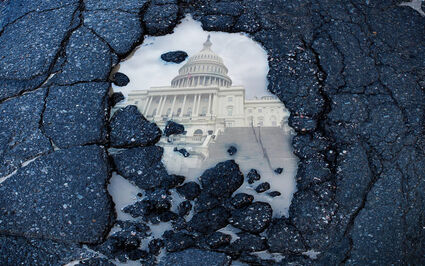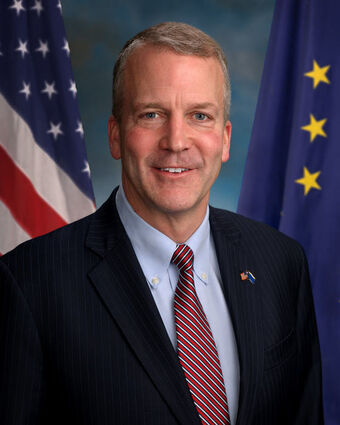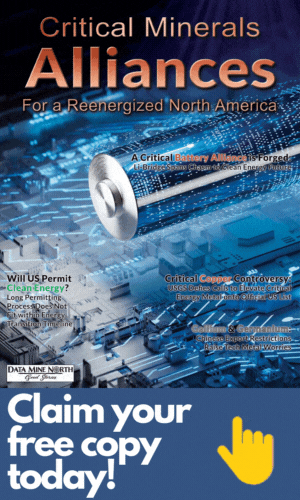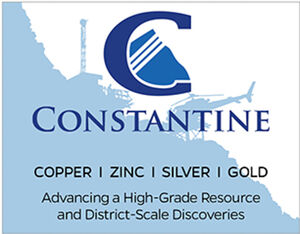Fed policies good, bad news for US miners
Infrastructure bill boosts demand, funds minerals research, streamlines mine permitting; reconciliation bill casts shadow North of 60 Mining News – December 3, 2021
Last updated 12/2/2021 at 1:26pm

Adobe Stock
The $1.2 trillion Infrastructure Investment and Jobs Act will provide billions of dollars for upgrading and expanding Alaska's sparse infrastructure.
The $1.2 trillion Infrastructure Investment and Jobs Act brightens an otherwise gloomy outlook when it comes to federal policies that impact Alaska and its mining sector.
"I believe this is truly historic for our state," Sen. Lisa Murkowski, R-Alaska, said during a Nov. 17 address at the Alaska Resources Conference.
While the massive infrastructure bill passage was chalked up as a political win for President Joe Biden, the billions of dollars to be invested into upgrading and expanding Alaska's sparse infrastructure will have an outsized impact on a state rightfully considered America's Last Frontier.
Sen. Dan Sullivan, R-Alaska, pointed out that Alaska has fewer road miles than Connecticut, a state about 120 times smaller.
"We are a resource-rich, infrastructure-poor state," he said during the annual conference hosted by the Resource Development Council of Alaska.
This is why Alaska's entire congressional delegation, all Republicans, as well as civic and political leaders across the 49th State, got behind the bipartisan legislation.
"It's going to be a lot of money ... billions of dollars to construct and modernize our roads, our bridges, our ports, our airports," said Murkowski. "It's not just going to be the opportunity for better roads, but to see more of them."
More roads could help make Alaska's rich mineral resources more competitive.
"It is often said that if Alaska's impressive mineral deposits were in the state of Nevada, with infrastructure like roads, ports, and energy grids, they would already be mines," said Alaska Miners Association Executive Director Deantha Skibinski. "We're pleased that the infrastructure package includes significant investment in building Alaska, which will make investment in resource development more attractive."
For Alaska's mining sector, however, provisions to streamline the federal mine permitting process may be even more important than the massive investments into roads, rails, ports, airports, and other infrastructure that will be built from the minerals and metals these mines could supply.
"The federal agencies are going to have a responsibility and a requirement to start issuing permits more efficiently and with less delay," said Murkowski.
Alaska's senior senator pushed back on the notion that the infrastructure bill is a bad thing because it is being chalked up as a win for the Biden administration.
"This is a win for the country, this is a solid win for Alaska," she said. "This not some kind of creeping socialism or Green New Deal."
Murkowski, on the other hand, says the partisan budget reconciliation bill crafted by Democrats could severely impact the development of the natural resource projects Alaska's economy depends on.
"The House reconciliation bill is entirely partisan, and nowhere more so than in its resource provisions," she said. "Those policies – which are all but designed to eliminate energy and mineral production in federal areas – are a gift to OPEC, Russia, and China at the worst possible time."
There, however, is an alternative energy vision being championed by Alaska's own Sen. Sullivan that endeavors to create American jobs and make the U.S. less dependent on foreign countries for its oil, natural gas, and critical mineral needs.
"Our vision recognizes that American natural resources can be leveraged to produce millions of jobs in related U.S. manufacturing sectors, including clean technology," Sullivan said when introducing the American Energy, Jobs & Climate Plan.
Critical minerals funding
In addition to the need for the enormous quantities of minerals and metals to upgrade America's roads, rails, bridges, ports, energy, and other infrastructure, the mining sector is poised to benefit greatly from critical minerals funding included the Biden administration's Infrastructure Investment and Jobs Act.
This includes more than $1.6 billion in critical minerals funding going to the United States Geological Survey and Department of Energy.
The infrastructure act allots $320 million over five years to USGS's Earth Mapping Resources Initiative to help characterize the distribution of critical minerals in the U.S.
Better known as Earth MRI, this program combines traditional geological work with the latest technologies in lidar, magnetic surveys, satellites, and unmanned aerial vehicles to seek out hidden stores of critical minerals such as cobalt, graphite, lithium, niobium, platinum group metals, rare earths, tin, and tungsten.
The Earth MRI funding included in the infrastructure bill is equivalent to roughly 30 years of U.S. critical mineral resources mapping covered by the previous budget of just over $10 million per year.
USGS was allocated another $167 million in the current fiscal year to establish a USGS-owned academic facility for energy and minerals research.
While USGS accelerates its Earth MRI program, DOE will have $400 million to award critical minerals mining and recycling research and development grants over the next four years.
The $100 million-per-year funding will continue investments DOE has made over the past years into diversifying the supply of, developing substitutes for, and improving the reuse and recycling of these metals critical for clean energy and high-tech applications.
"Expanding electric vehicle infrastructure, hardening our nation's electrical grid, and powering our economy with millions of clean energy jobs all rely on securing supply chains of critical materials like cobalt and platinum," Secretary of Energy Jennifer Granholm said earlier this year.
The infrastructure bill also provides DOE with $140 million this year to establish a rare earths research facility.
Streamlining U.S. mine permitting
Policies to streamline federal mine permitting included in the Infrastructure Investment and Jobs Act offer another bright spot for America's mining sector.
"When it comes to mining, we took the real first step in decades when it comes to mine permitting," said Murkowski.
This includes permanent authorization of the Fast-41 permitting dashboard, which was established in 2015 to improve the timeliness, predictability, and transparency of federal environmental review and authorization process for domestic infrastructure projects.
Short for Title 41 of the Fixing America's Surface Transportation Act, Fast-41 created the Federal Permitting Improvement Steering Council (FPISC), a unique federal entity that provides a one-stop-shop capable of coordinating permits across different federal agencies, thereby streamlining and shortening the overall process for large infrastructure projects that are eligible for the program.
Recognizing that minerals and metals are a vital input into the front end of America's infrastructure supply chains, federal officials voted to make certain mining projects eligible for Fast-41 permitting.
Murkowski says the federal coordination offered by the FPISC and the Fast-41 dashboard has reduced the federal permitting timeline for large projects from 4.5 to 2.5 years.
Alaska mine projects poised to deliver minerals critical to America's infrastructure, such as Graphite One Inc.'s Graphite Creek and Ucore Rare Metals Inc.'s Bokan Mountain rare earths projects, would be eligible for the Fast-41 program.
The infrastructure bill also fully enacts the American Minerals Security Act coauthored by senators Murkowski and Joe Manchin, D-W.Va., which directs the White House to "coordinate the appropriate agencies to implement U.S. policy regarding critical minerals, including to establish an analytical and forecasting capability for identifying critical mineral market factors so as to avoid supply shortages, mitigate price volatility, and prepare for demand growth and other market shifts."
Alaska's senior senator says this legislation will improve the timeliness and efficiency for the permitting of critical mineral projects such as Graphite Creek, Bokan Mountain, and the cobalt enriched Upper Kobuk Mineral Projects in Alaska's Ambler Mining District.
The number of critical mineral projects in Alaska would expand significantly if the USGS proposal to add nickel and zinc to the list of minerals critical to the U.S. is finalized.
"The USGS's critical minerals list provides vital information for industry, policymakers, economists and scientists on the most important minerals when it comes to U.S. supply chains," Assistant Secretary of the Interior for Water and Science Tanya Trujillo said when the proposed list of 50 critical minerals was released for 30 days of public comment on Nov. 9.
Worrisome reconciliation bill
While the billions of dollars of Alaska infrastructure upgrades and mine permitting reforms packed into the $1.2 trillion Infrastructure Investment and Jobs Act is something the Alaska delegation could get behind, the even larger budget reconciliation bill being crafted by Democrats worries the trio.
"We don't know what is in it – the Democrats are working it through behind closed doors, the Republicans are solidly shut out of the process and have been from day one," said Murkowski.
America's mining sector, however, had a pair of champions behind those closed doors.
This includes Sen. Manchin, who helped reduce some of the more onerous mining provisions proposed by his Democrat colleagues.
"He is currently considered the most important Joe in Washington D.C., even beating out the president for that title," National Mining Association Executive Vice President Katie Sweeney said during a Nov. 4 online breakfast meeting hosted by the Resource Development Council of Alaska.
This is because Manchin, a more conservative Democrat, can and has held up some of the more liberal bills in an equally split Senate.
Sen. Catherine Cortez Masto, D-Nev., also helped remove some of the more onerous provisions from the reconciliation bill before it went up for a vote in the House.
The reconciliation bill originally included new gross mineral royalties of 8% on new and 4% on existing mining operations on mineral lands.
As a senator for one of the top mining jurisdictions on Earth, Cortez Masto drew a line in the Nevada sand, forcing her colleagues to remove these steep mining taxes from the reconciliation bill.
The reconciliation bill also originally included 20% royalties on new federal leases, which was stripped from the $2.2 trillion measure known as the Social Safety Net and Climate Bill that was narrowly passed in the House on Nov. 19.
While the worst of the mining provisions were removed from the reconciliation bill that is now in the Senate, Alaska's delegation sharply criticized the measure due to remaining provisions that would harm Alaska's ability to responsibly produce energy and mineral resources needed by the rest of the country and the world.
The most detrimental, according to the Alaska lawmakers, is a repeal of the oil and gas program for the non-wilderness portion of the Arctic National Wildlife Refuge.
"In the midst of high energy prices and mounting inflation, responsible domestic production from Alaska, including the prospective 1002 Area is needed more than ever," Murkowski said.
Congressman Don Young, R-Alaska, said he is disappointed but not surprised by this move by House colleagues.
"Democrats insist that the bill they passed this morning will help us 'Build Back Better,' but with the anti-ANWR provisions included in the bill, all they will accomplish is a betrayal of our dedicated energy workers and their families, forcing them to 'Build Back Broke,'" he said following the Nov. 19 passage of the reconciliation bill.
"If the concern is carbon emissions, what sense does it make to shut down responsible energy production in ANWR only to force a greater reliance on foreign oil from countries with far lower environmental standards?" he queried.
Sen. Sullivan called the provisions of the reconciliation bill the latest salvo in "an all-out war on Alaska's economy and the domestic energy sector."
"The bottom line is this: In the middle of a nationwide energy price spike, President Biden is intent on giving pink slips to hard-working Americans and Alaskans and decimating the U.S. energy sector, while begging OPEC and Russia to produce more oil," he said.
Manchin and a handful of moderate Democratic senators have not committed to voting on the reconciliation bill passed by the House. The measure is considered a nonstarter without all Democratic senators on board.
Sullivan's energy plan
With the idea that developing abundant domestic resources is both better for American workers and the global climate than the progressive policies that are pushing gas and home heating fuel prices higher, Senators Sullivan, Kevin Cramer, R-N.D., and Cynthia Lummis, R-Wyo., recently introduced the American Energy, Jobs & Climate Plan.
Sullivan says the higher heating costs being levied on Americans is not an unfortunate byproduct of federal policies but an outcome desired by the White House.
"From day one, this administration has actually set on a purposeful course to really crank up energy prices on the backs of working Americans," said the Alaska senator. "When it is costing 40 to 50% more to fill up your car or your truck to go to work or to go out at Thanksgiving to visit family and friends, people notice."
The competing vision put forward by Sullivan, Cramer, and Lummis is built upon five pillars:
• Expand current power and energy production base to leverage America's world-class energy resources.
• Support infrastructure, resources, investments, and incentives to build out the American renewable energy manufacturing and electricity sector.
• Leverage America's energy and natural resource abundance and independence to create millions of good-paying jobs in the energy and manufacturing sectors.
• Enact permitting reform to ensure all energy, mineral, and infrastructure projects can be built in an efficient, timely, and certain manner.
• Take advantage of America's abundant energy and natural resources to rebuild the American supply chain.
By meeting domestic energy needs with oil, gas, and critical minerals produced under America's strict environmental standards, the crafters of the American Energy, Jobs & Climate Plan say this strategy has the potential to reduce global emissions by up to 40% by 2050.
"Our framework is based on American abundance and leveraging America's many unique strengths, especially our world-class natural resources, whose production has actually brought down emissions and the lowest carbon intensive manufacturing in the world," said Sullivan.
This includes domestic mining of the critical minerals metals needed to build America's electric vehicles and renewable energy sectors, commodities that are abundant in Sullivan's home state.
"Right now, we are importing the vast majority of those from China," the Alaska senator said during a Nov. 17 address at the Alaska Resources Conference.
The sponsors of the American Energy, Jobs & Climate Plan believe their strategy to improve the climate, bring down energy costs, and create jobs is something all Americans can get behind.
"We believe our vision and framework is mainstream. It's common sense and has the potential to be bipartisan," said Sullivan.



















Reader Comments(0)